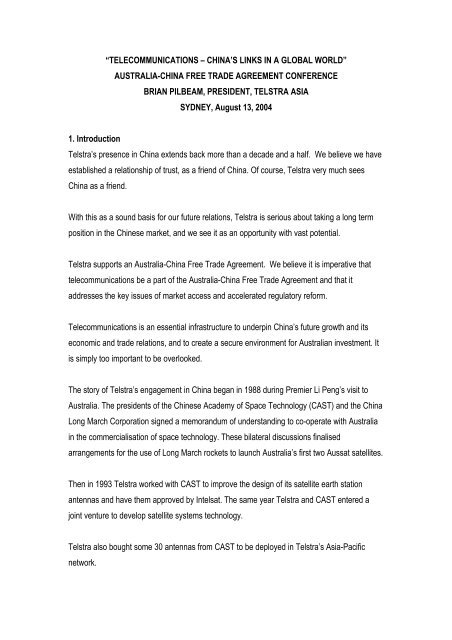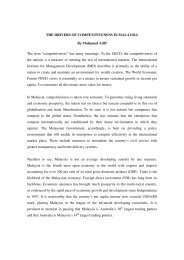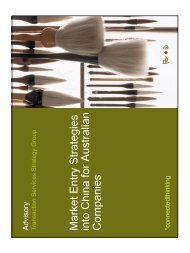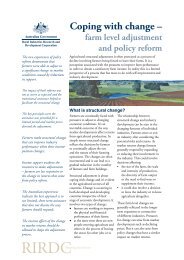australia-china free trade agreement conference brian pilbeam, pr
australia-china free trade agreement conference brian pilbeam, pr
australia-china free trade agreement conference brian pilbeam, pr
Create successful ePaper yourself
Turn your PDF publications into a flip-book with our unique Google optimized e-Paper software.
“TELECOMMUNICATIONS – CHINA’S LINKS IN A GLOBAL WORLD”AUSTRALIA-CHINA FREE TRADE AGREEMENT CONFERENCEBRIAN PILBEAM, PRESIDENT, TELSTRA ASIASYDNEY, August 13, 20041. IntroductionTelstra’s <strong>pr</strong>esence in China extends back more than a decade and a half. We believe we haveestablished a relationship of trust, as a friend of China. Of course, Telstra very much seesChina as a friend.With this as a sound basis for our future relations, Telstra is serious about taking a long termposition in the Chinese market, and we see it as an opportunity with vast potential.Telstra supports an Australia-China Free Trade Agreement. We believe it is imperative thattelecommunications be a part of the Australia-China Free Trade Agreement and that itaddresses the key issues of market access and accelerated regulatory reform.Telecommunications is an essential infrastructure to underpin China’s future growth and itseconomic and <strong>trade</strong> relations, and to create a secure environment for Australian investment. Itis simply too important to be overlooked.The story of Telstra’s engagement in China began in 1988 during Premier Li Peng’s visit toAustralia. The <strong>pr</strong>esidents of the Chinese Academy of Space Technology (CAST) and the ChinaLong March Corporation signed a memorandum of understanding to co-operate with Australiain the commercialisation of space technology. These bilateral discussions finalisedarrangements for the use of Long March rockets to launch Australia’s first two Aussat satellites.Then in 1993 Telstra worked with CAST to im<strong>pr</strong>ove the design of its satellite earth stationantennas and have them ap<strong>pr</strong>oved by Intelsat. The same year Telstra and CAST entered ajoint venture to develop satellite systems technology.Telstra also bought some 30 antennas from CAST to be deployed in Telstra’s Asia-Pacificnetwork.
2At the same time, in Shanghai – when Pudong was little more than fields, we were involved in afeasibility study and the design of conceptual network systems infrastructure for developmentof the New Pudong Area, including its airport – some eight years ahead of AT&T’s signing of anoperations <strong>agreement</strong> for the area.Two years later, in 1995, we opened our re<strong>pr</strong>esentative office in Beijing to build on ourrelationship with China firsthand and direct our drive into the world’s fastest growing economyand market. In the following year, Telstra concluded one-stop-shop <strong>agreement</strong>s with the thenBeijing, Guangdong and Shanghai Post and Telecommunication Authorities establishing thebilateral requirements needed to serve multinational corporations operating in both Australiaand China.We were accorded formal recognition of the strength of our friendship in 2000 when TelstraCEO, Dr Ziggy Switkowski, was appointed to the Mayor of Shanghai’s International BusinessLeaders’ Advisory Council, a ‘who’s who’ list re<strong>pr</strong>esenting global business.Our long involvement as well as these business networks and relationships are clear evidenceof the critical role of telecommunications in China’s development.Commodities and manufactures have been the focal points in the debate on <strong>trade</strong> with China.The debate is now shifting to the services arena.China’s future development as a global trading nation will require integrated communicationsnetworks, and the wide array of telecommunications services, to connect the country internallyand link it to the international community 24 hours a day.2. Market access strategiesRecognising that Hong Kong is part of China, Telstra now has a significant Chinese <strong>pr</strong>esence.Our focus is on furthering opportunities afforded by our current initiatives:Telstra Asia – the umbrella for our activities in Asia;CSL – Hong Kong’s <strong>pr</strong>emium <strong>pr</strong>ovider of mobile voice and data services, which hasone million customers;
3REACH – a 50:50 joint venture which is Asia’s largest international wholesale carrier ofvoice, <strong>pr</strong>ivate leased circuit and data services;KAZ – Telstra’s newly acquired IT services business, with a significant Hong Kong<strong>pr</strong>esence; andTelstra Global Solutions - <strong>pr</strong>oviding connectivity for multinational corporations, such asHyatt’s Beijing Hotel to the company headquarters in Chicago.Telstra is extremely well placed to <strong>pr</strong>ovide the skills and experience in service delivery that areattractive to Chinese partners and required by Chinese enter<strong>pr</strong>ises and consumers.Our experience with the Olympics is a pertinent case.For the Sydney 2000 Games, Telstra was the sole telecommunications <strong>pr</strong>ovider, delivering notonly basic communications but also links for international broadcasters, EFTPOS services andscoreboards at the venues. This was a critical service that ensured the Games ran smoothlyand was determinant in how well they were perceived.From the opening of the Olympics today in Athens, Channel Seven will utilise our InternetProtocol network for its communications links between Greece and Australia.In light of our gold medal performance in Sydney Telstra has been employed astelecommunications adviser to BOCOG, the Beijing Organising Committee for the OlympicGames.The Games are key to China’s emergence on the world stage. Our role will be to advise theorganising committee on what the Chinese carriers need to do for Beijing’s Olympics to achieveworld class standards. It is an important step to elevate Telstra’s reputation in the Chinesemarket and also a unique entrée for us to new business partnerships with the main players inChina.3. China – opportunities and relationshipsWhile the physical challenges of building telecommunications infrastructure across vastgeographic distances with low population densities are the same for both Australia and China,
4Telstra believes the differences in the two countries’ stages of development create significantbusiness opportunities.China is already the world’s largest market for mobiles, but it is in customer service levels thatTelstra believes it can make a significant contribution to the Chinese market. We know whatservices, as opposed to infrastructure, blue-chip customers are seeking.The Yellow Pages is a simple example. In Western countries, it is second nature for companiesto use this medium to advertise their services, but there is hardly any equivalent in China. I amsure that Sensis, Telstra’s directories business, could offer a lot to a Chinese carrier looking todevelop these services increasingly demanded by customers.We understand the opportunities and benefits, having experienced competitive reforms inAustralia over the past 20 years to deregulate and open up its economy, as well as our mostrecent experience in the global economy.But we need to ap<strong>pr</strong>eciate that, despite the rich history of cities such as Shanghai andGuangzhou, China is a newcomer to current international <strong>trade</strong> and investment regimes. Andthe changing dynamics that come into play as a consequence means it faces somefundamental growth challenges.China is already <strong>pr</strong>oducing goods on a scale that puts it in the top international ranks. AsAmbassador Madame Fu Ying told the National Press Club in Canberra last month, Chinamakes one of every two cameras that are sold around the world, as well as one of every threeTV sets and one of every three air-conditioners.If China wants to continue to grow its economy and to move to higher-value specialised<strong>pr</strong>oducts with skilled staff and knowledge workers, it will need robust telecommunicationservices to glue together the various economic clusters and activities and create the rightclimate for sustainable growth.It is critical for China to develop reliable, customer-focused telecommunications in tandem withits overall economic strategy.
5Let me <strong>pr</strong>esent a hypothetical case, but one that will give you a <strong>pr</strong>actical illustration of thebenefits of having a world class telecommunications “services” environment.For example a specialised nickel <strong>pr</strong>oducts mill in Hebei receives an order electronically from aFrankfurt high technology company. The mill relies on just-in-time <strong>pr</strong>ocessing and places anorder with BHP Billiton.On email instruction, a ship heads to Newcastle to collect the raw materials and transport themto Tianjin, and similar components are ordered from other parts of China and the region.Satellite navigation on the ship gives the mill pinpoint accuracy as to all the raw materials’arrival time.Meanwhile the company’s design staff in its Nanjing and Guangzhou offices are able tocollaborate, sharing files via a Virtual Private Network as though they were sitting next to eachother. They send these data-rich files to the mill, specifying how to make what the customerhas ordered.Production is completed and shipped to Hamburg. Satellite navigation means the customerknows when the delivery will arrive and the mill knows when to issue the bill.Upon receipt of the <strong>pr</strong>oduct, the customer transfers payment electronically from its HSBC bankaccount, using a secure network.That shows you the enormous advantage to be gained by creating the infrastructure linkbetween the <strong>pr</strong>oductive economy and its global markets. It’s the generational differencebetween the industrial era and the new economy that uses communications and technology forits leverage.Much of the infrastructure required to <strong>pr</strong>ovide such services exists in China today. However,the telecommunication services layer required to integrate disparate systems and <strong>pr</strong>ovide theend-to-end solution I just described does not yet exist.Australia has the benefit of some years’ experience with a deregulated telecommunicationsmarket, which has injected major benefit into the Australian economy.
6The Chinese Government has set itself the objective of quadrupling China’s GDP by the middleof the century.Telecommunications are a vital ingredient for achieving such an economic objective.From 1997, with the advent of full deregulation, telecommunications had become the country’sfastest growing industry, and tracking by the Australian Bureau of Statistics shows the industrycontinues to grow and at an increasing rate. 1As a result, many foreign-owned carriers, including Chinese-owned telecoms companies, suchas Asia Netcom, are already very active in the Australian market.Supporting the ABS analysis, the Productivity Commission found this year Australia had thefourth highest ICT contribution to GDP in the second half of the 1990s. The commissionobserved Australia’s <strong>pr</strong>o-competitive policies are of particular importance to the ability ofbusiness to realise the potential for ICT-related <strong>pr</strong>oductivity gains.4. The FTA and telecommunicationsChina has already made some important steps along this <strong>pr</strong>o-competition path. Itscommitments under its entry to the WTO are quite explicit.However, despite these important advances, our experience is that various barriers to entry,both explicit and more subtle bureaucratic hurdles, make any business case difficult.Telecommunications has its own special rules that are more onerous than those covering otherservice sectors, and quite apart from general foreign investment legislation in ChinaAs a result, most of the business opportunities Telstra has explored on the mainland haveultimately been frustrated by a combination of <strong>pr</strong>ohibitive regulatory and business factors thatapply to the telecommunications services market.1 From ABS 2001 Special Article: History of Telecommunications in Australia, updated 22/4/04- see at:http://www.abs.gov.au/Ausstats/abs@.nsf/0/B6C38ACB7D28699CCA2569DE0028DE97?Open
7We have looked at quite a number of ventures, but in the end have not invested for a variety ofreasons.In one case it was impossible to determine whether a series of ventures were legal, and therewas no clear path to increase our stake in them over time. In another <strong>pr</strong>oposed venture inShanghai, the business would have had to be set up as an entity under China’s ForeignInvested Telecommunication Enter<strong>pr</strong>ise Regulations and obtain a licence. This, again, is arequirement specific to telecommunications and would have delayed start-up by a year ormore. In this case, time to market was a critical factor in the business case.Additionally, the rules for foreign investment in Chinese carriers <strong>pr</strong>oviding basic services will bepermitted only from December this year, and only up to 25%, and only within the geographicalboundaries of Beijing, Shanghai and Guangzhou. The geographical restrictions are to beremoved by the end of 2007, but even then the maximum foreign equity stake will be capped at49%. In effect, China’s regulations permit participation with only a very limited set of potentialpartners, and these potential partners aren’t in any way required to embrace foreign jointventures.These limitations on our opportunity to invest in China are in stark contrast to the almostcomplete <strong>free</strong>dom available to foreign investors in Australian telecommunications services.There’s also a considerable element of risk that constrains investment in value added servicesin China, with the anachronistic fax services being one of the few things that we know with anyconfidence that we are ex<strong>pr</strong>essly allowed to do.I should emphasise in this context that any commitment on Telstra’s part would have to meetour investment criteria. We have a clear set of criteria for ap<strong>pr</strong>aising whether an investmentoption is suitable.One of these concerns is the regulatory environment. In respect of China, we need to besatisfied that its regulatory regime gives sufficient clarity and consistency for us to be confidentabout investing. The fact that, to date, - we have chosen - not to make significant investmentsis telling. Neither we, nor any credible international operators, are willing to play in grey areas.
8One reason why the investment environment in Chinese telecommunications is so challenging,is that China has no <strong>pr</strong>imary telecommunications legislation. However, this situation is soongoing to change: after many years of drafting, the new Chinese telecommunications law is in itsfinal stages and will come before the State Council very shortly.Reports on the draft law suggest that there is much that foreign investors will find encouraging.Unlike the current Services Classification Catalogue with its narrow inter<strong>pr</strong>etation of foreignparticipation in Value-Added and Basic Telecoms Services, we understand that the passage ofthe new telecoms law will greatly expand opportunities. It is particularly important that, coupledwith the new telecoms law, foreign investors should be accorded the full benefits of nationaltreatment within the scope of China's WTO commitments.The FTA offers the <strong>pr</strong>ospect of accelerating access and establishing a <strong>pr</strong>ocess for formaldialogue to sort out the issues I’ve detailed – <strong>pr</strong>ovided it contains particular reference totelecommunications.Firstly, Telstra is strongly committed to the view that the FTA should include a specificcomponent on telecommunications services to <strong>pr</strong>ovide for im<strong>pr</strong>oved market access. If in theend the FTA incorporates mechanisms to bring greater parity in the overall investmentopportunities available to each of our countries, this would strengthen Telstra’s position.Secondly, on the issue of regulation, we recognise there are significant differences betweenour regimes in terms of both industry regulation and competition policy. Australia has hadcompetition in the telecommunications area since the entry of Optus in 1992, while China’smarket opening <strong>pr</strong>ocess has only just begun.Telstra’s <strong>pr</strong>eferred option would be the development of a regulatory regime in China that islargely harmonised with conditions in Australia. The long term aim of a telecommunicationschapter in a FTA could be ex<strong>pr</strong>essed as a harmonisation of the two regulatory regimes, andthat their regulation should reflect international norms.It is Telstra’s understanding that China’s Ministry of Information Industry, or MII, holds thecurrent Australian model of telecommunications regulation in high regard. Therefore, Telstra
9<strong>pr</strong>oposes that the scope of a FTA include a ‘Statement of Principles of Best PracticeRegulation’, to which both countries would subscribe.This would set in place the guidelines for a workable path to harmonisation. It would <strong>pr</strong>ovide forbilateral arrangements, under which stretch targets could be set for us to work towards thisobjective. That is particularly important from Telstra’s position.At the government level, the <strong>agreement</strong> should incorporate the WTO rules to create a flexiblemechanism for ministers to meet regularly to canvass common issues.But let’s also look creatively at some of the ways we could ap<strong>pr</strong>oach this. On our doorstep, wecan draw on the example of the Australia-New Zealand Closer Economic Relations <strong>agreement</strong>.Here we have the most com<strong>pr</strong>ehensive, effective and mutually compatible <strong>free</strong> <strong>trade</strong><strong>agreement</strong> in the world and one of the most successful examples of economic integration.The CER <strong>agreement</strong> is a role model that goes beyond the standard FTA concept, <strong>pr</strong>oviding aforum for debate and allowing interchanges between the Australian Consumer and CompetitionCouncil and the New Zealand Commerce Commission.Significant advantage could be gained by developing a similar partnership with China’s StateCouncil for Information or the MII.Additionally, benefit could be gained as China <strong>pr</strong>epares to become a more customer-focusedtrading nation in encouraging the Australian Telecommunications Users’ Group or itsinternational counterpart, INTUG, to create a better understanding among the Chinese carriersas to what standards customers expect in a global world.There is already a model on which this could be based. A body structured on these lines existsin Hong Kong, one of the world’s major global business regimes.5. ConclusionSumming up, Telstra is keen to work with both Governments to achieve telecommunicationscomponent in an FTA on China. We believe the <strong>agreement</strong> could yield enormous economic
10benefits and elevate the relationship that has been developing between our two countries sincethe 1970s to a more substantive, more formal level.We support the <strong>pr</strong>inciple set out in the existing Trade and Economic Framework that a bilateral<strong>agreement</strong> is important for direct relationships between governments, businesses and people,as well as for economic benefit. That <strong>pr</strong>inciple would be strengthened within the format of aFTA as the basis for establishing dialogues and bringing about a more co-operative ap<strong>pr</strong>oachto resolve issues.The basic reasoning for the FTA is to establish <strong>free</strong> <strong>trade</strong> opportunities, and Telstra would beconcerned with any unnecessary restriction or omission that might hinder us in moving in thatdirection.Instead, we should envisage it as the vehicle to advance towards mutual access and thatcreates advantage for both countries in global <strong>trade</strong> and investment.From a telecommunications perspective, we see the development of relationships for ourindustry in terms of a FTA pyramid. At the base of this would be a simple reiteration of bothcountries’ WTO commitments.Higher up the pyramid would be more flexible and creative elements such as stretch targetswith specificity about real partnerships to be achieved within reasonable timeframes.At the apex of the pyramid would be a full FTA with a full telecommunications chapter,harmonising the regimes between the two countries.The Australian government has signed up for four other FTAs: New Zealand; Singapore;Thailand; and the US. A <strong>pr</strong>ecedent has been set whereby all make reference totelecommunications and market access for Australian businesses.Telstra supports an FTA between Australia and China and firmly believes that incorporatingtelecommunications would benefit both countries.ENDS
















